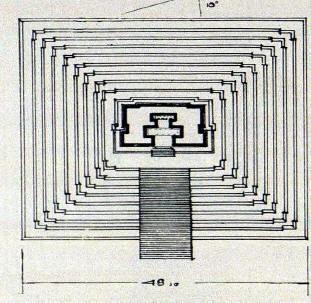Grid of the Gods (59 page)
Authors: Joseph P. Farrell,Scott D. de Hart

It is this fact that, at least with respect to the Great Pyramid, also means that the structure was deliberately conceived as a higher- dimensional analogue, for as most investigators are aware, the Great Pyramid is built as an example of “squaring the circle” and “cubing the sphere,”
24
it is built, in other words, according to the very technique of higher-dimensional geometry.
25
d. Tetrahedral and Octahedral Groups
We noted, previously, that there was a peculiar connection between Sumerian notation and the type of notation used by geometers in higher-dimensional mathematics. Before exploring that connection, it is worth mentioning that there is another deep connection between the Sumerian sexagesimal numerical system, based upon multiples of the number 6, and that of higher dimensional geometry. Coxeter notes that in the rotation groups of polyhedra, that there are three groups in particular:
…(we) have the
tetrahedral
group of order 12, the
octahedral
group of order 24 (which is also the rotation group of the cube) and the
icosahedral
group group of order 60 (which is also the rotation group of the dodecahedron).
26
While consideration of rotation groups would far exceed the technical limitations of presenting higher-dimensional geometries to a general audience, it is worth noting that all these numbers are “Sumerian” in that they are all multiples of 6! And this brings us at last to the other peculiar Sumerian connection.
e. Schl㥬i Numbers, the Platonic Solids, and Their Extensions
Ludwig Schl㥬i (1814-1895) was the Swiss mathematician who first investigated regular polytopes in more than three dimensions, deriving a simple method of representing the counting of the numbers of vertices and faces.
27
Schl㥬i’s notation convention, for regular polyhedra in three dimensions, is a symbol comprising two numbers, p and q, which looks like this:
{p,q},
where p is the number of sides of a face of a regular polygon and q is the number of faces around each vertex. A cube would thus look like this:
{4,3}
with the four denoting the equal sides of a square’s face, with three such faces around each vertex.
28
The notation convention is strongly
reminiscent of Schwaller de Lubicz’s understanding that numbers represent geometrical functions, and of the Sumerian notation convention where, similarly, the numbers denote functions of cubing or squaring, or of some other function of multiplication.
29
As more dimensions are added, the number expands: {p, q, r…}.
C. Counting Faces and Vertices In Mexico and Meso-America
We have already observed that the Great Pyramid in particular is an actual analogue of the technique of squaring the circle, a crucial step in the kind of analysis and technique geometers utilize to describe higher-dimensional objects. But expressed in terms of a Schl㥬i number, there is nothing so unique about them; they have five vertices, four triangular faces, and one square face. One would have to “adjust” the notation to reflect this fact, but it could be easily done.
It is when one turns to the pyramidal structures in Mexico and Meso-America that one is confronted with something
very
interesting, as the following charts and diagrams of the various pyramids of Teotihuacan and Tikal demonstrate.

Harrelson’s Overview of the Pyramid of the Sun at Teotihuacan
30

Overview of Small Pyramid At Tikal
31

Small Pyramid At Tikal: Front View

Perspective View of Small Tikal Pyramid

Tikal: Temples I & II: Front, Side, and Overhead Views

Tikal Temple I: Overhead

Tikal Temple II: Overhead

Tikal Temple III: Overhead

Tikal Temple IV Overhead

